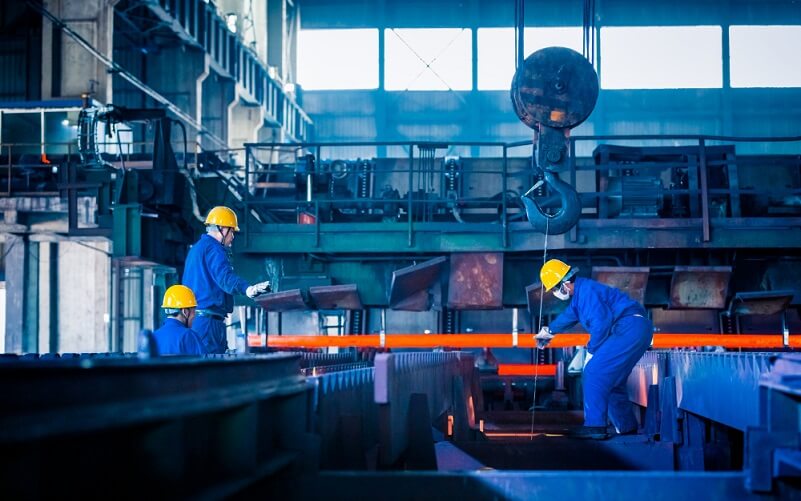
1. Visualizing industry 4.0 in action
Change does not occur overnight. It happens in small steps. Gigabyte after Gigabyte. This is the Industry 4.0 design. Regardless of their current integrations, manufacturers are already in Industry 4.0 territory. The digital transformation’s success depends on how they use it as a strategic goal to ensure a more efficient and profitable future. This new business paradigm does not necessitate an all-or-nothing strategy. Even improving a single firm area may serve as an evolutionary catalyst, moving manufacturing facilities and organizations toward a more efficient and sustainable future.
To kickstart an Industry 4.0 transformation, four governing areas of manufacturing can be optimized.
The possibilities are endless from here.
- Methodology
Methodology optimization can reduce risk, increase efficiency, and automate repetitive tasks. - Skilled Workforce Make changes to assist your workforce significantly in coordinating, preparing, producing, and growing.
- Assets
If mechanic operations and downtime are a concern, concentrate on assets and machinery. - Customer satisfaction
Interact with customers, solicit feedback, and implement changes directly related to customer satisfaction.
2. Better performing algorithms
Inefficiencies that can cripple manufacturing processes now have a new adversary in the form of Industry 4.0 innovations. Artificial intelligence (AI) and advanced commercial software systems may identify the fundamental cause of key problems, such as poor performance or quality and possible bottlenecks while revealing new development options. In addition, predictive analytics is more accessible than ever, enabling teams to automate repetitive processes and spot possible red flags, streamlining the production cycle and clearing away operational bottlenecks.
Enhanced data management• Reduce the need for manual data analysis by using systems that scan datasets for outliers, incorrect data, and potential for misinterpretation.
Analysis of Workflow
• AI can investigate a system using machine learning and algorithmic functions to find margins of error, inefficiencies, and repetitive operations that can be automated. With this approach in place, no human resources are required to evaluate faulty procedures.
Strategic planning
• Using business planning software or an ERP system, manufacturers can obtain visibility into their operations for increased transparency, allowing them to make better decisions. This aids in the optimization of critical business components such as financial planning, replenishment, lifecycle planning, and more.
Global interconnection
• A well-connected network of suppliers, manufacturers, brokers, and third-party logistics providers (third-party logistics providers) can open up the possibility for collaboration and predictive intelligence. This strengthens the supply chain from beginning to end, establishing trust between the supply chain network and the distribution company.
3. The workforce of the future
An Industry 4.0 plan that is wholly implemented bridges the expanding skills gap by combining human talent with modern technology such as artificial intelligence (AI), intelligent dashboards, seamless communication, and more accessible service areas. Consider a scenario in which employees enhance output with the assistance of intelligent robots and interact more effectively with organizational tools in the palm of their hand.
Retention of talentWorkforce modernization will promote alignment across manufacturing teams by making precise data management and machine learning available via intelligent dashboards and technological communication tools that reduce tension and boost team member happiness.
Improved training and education
ERP platforms can provide mobile access to work detailed instructions, guidance, and advice to assist manufacturers in enhancing plant operations and expanding their service business and geographical coverage.
Effective interaction
Continuous connectivity positively affects all production channels. Cloud-based applications can facilitate more open interaction and collaboration across projects by creating a more connected network of workers.
Reduced "idle" human time
The use of collaborative robotics ("cobots") can reduce human idle time by as much as 85 percent.
Effectiveness and quality
When firms integrate intelligent technology into their employees, productivity increases by 63%, while overall quality increases by 21%.
Higher engagement, lower risk
When an ERP or other management system adopts repetitive administrative duties, human workers can make rational decisions that need human intellect, emotional intelligence, and more nuanced handling, decreasing the likelihood of human errors.
4. Automated asset management
When manufacturers emphasize asset optimization to advance towards Industry 4.0 unification, they commit to a path that will boost plant productivity, minimize downtime, and promote machinery longevity. Industry 4.0 creates a world where it is virtually always possible to plan for and avert the worst-case scenario.
Maintenance management• With the introduction of the internet of things (IoT), inexpensive sensors can monitor equipment for signals of performance issues, downtime, or upcoming maintenance. These sensors can measure temperature, vibration, and rotation, among other variables. As part of your IoT strategy, enterprise asset management (EAM) systems' aggregated data can detect mechanical deterioration and downtime risk before they affect production.
Sustainability
• Taking a standard approach to asset management and maintenance can enhance the overall sustainability of the manufacturing plant, both in terms of energy efficiency and financial sustainability, by ensuring that machines are serviced before they fail and monitoring energy expenditure. This is best accomplished using an EAM solution.
5. Curated customer experiences
Industry 4.0 hinges on connection. It is the convergence of machines, technology, individuals, processes, and customers. With Industry 4.0, there are new norms of interaction, and they all revolve around creating an interactive, personalized experience for customers across all transactions. In the era of Industry 4.0, feedback is the money, and an investment in customer satisfaction is a commitment to the future of production.
CustomizationCustomers want a say in every step of the buying and selling process. Involving clients in a guided purchasing process that includes improved search capabilities, product flexibility, and a rapid estimate of delivery time and the cost is possible with innovative solutions like configure-price-quote (CPQ) software.
Tracking
As global positioning systems (GPS) and radio-frequency identification (RFID) have become more widespread, they have allowed businesses and consumers to stay in touch throughout the sales process. Another factor contributing to openness in operations is that customers have more visibility into the production and delivery of their products.
Behavioral norms
eCommerce will continue to grow with the advancement of online platforms and data analytics to analyze consumer behavior patterns, product demands, and purchase behavior. Better personalization is in everyone's interest. Thus this technology is a win-win for consumers and businesses.
6. A future with significant integration
Manufacturers began using Industry 4.0 approaches years before the period was formally defined; yet, the relationship enables a successful integration. As a result, future factories will have systems, devices, materials, people, and processes that collaborate to maintain, automate, and meet the expanding demands of the manufacturing industry.
7. Checklist for Industry 4.0 contingency planning
Identifying the basic framework for implementation and optimizationGiven the four pillars of Industry 4.0, choosing where to start or how to develop a use case for your implementation efforts might be challenging. However, even if the bulk of manufacturers may still be using techniques founded on the concepts of earlier industrial revolutions, this does not imply that their foundations shackle them. There are many questions manufacturers may employ to determine their starting place in the race to Industry 4.0 synthesis.
Use these questions to find possible operational improvement opportunities. In addition, by investigating these common pain points, it will be simpler to identify the areas where Industry 4.0-friendly solutions may be most simply implemented.
Process- Is your company model adapted for the digital age, or does it mainly depend on manual processes, even recurring tasks?
- Do your items and distribution records satisfy present-day demand?
- Do customer experience influence workflow and process?
- Is your supply chain fragmented or the cause of production or distribution delays?
- Does your team have a significant quantity of "downtime"?
- Is your talent reluctant to change or nearing retirement age?
- Do you constantly and effectively attract fresh talent?
- Is there efficient horizontal and vertical communication between teams?
- Does digital optimization include training and onboarding?
- Does your equipment need routine or unscheduled maintenance?
- How many items are manufactured versus in circulation?
- What is your supply and demand ratio?
- Do you provide new and enhanced goods and services to satisfy market demands?
- Are product manufacturing and distribution time-consuming?
- Does client input affect the optimization or adaption of processes?
- Can consumers monitor or personalize their purchases?
8. Ready to take off
Here is where your link to the future begins.You are at the current moment, yet you have seen the future of manufacturing. It is now time to take yet another step toward growth. The question isn't any more "What can Industry 4.0 accomplish for my company?" but rather "What is my first step in the development of Industry 4.0?"

